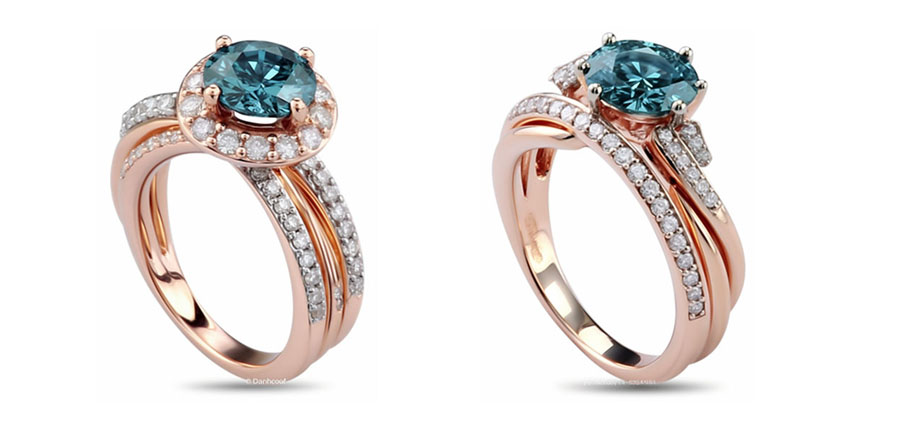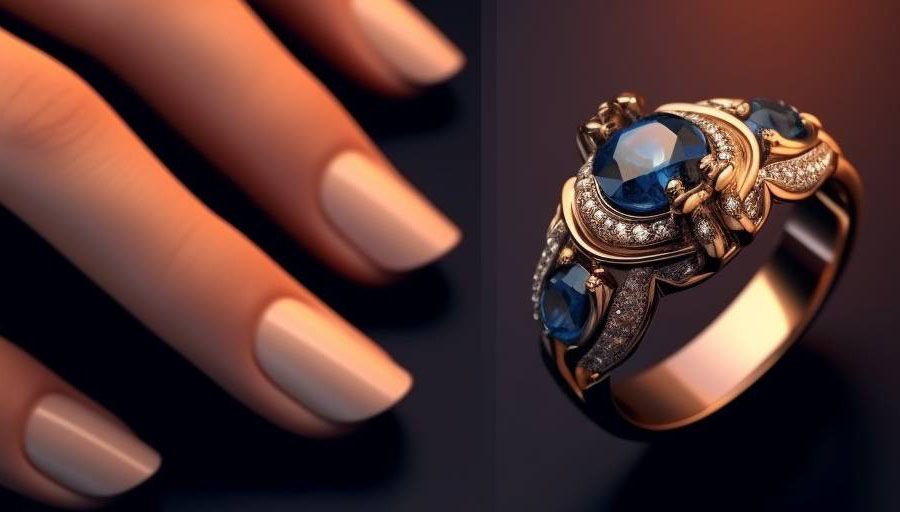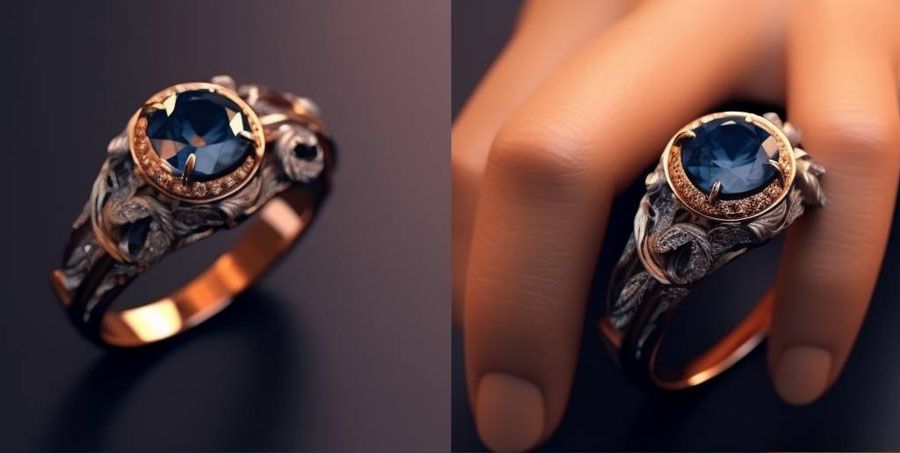What are the best settings for a blue diamond ring?
Key Takeaway:
- The color and appearance of a diamond can be affected by its setting. Choosing the right metal for the setting, such as platinum or white gold, can make a diamond look less yellow. The reflective nature of diamonds means that the color of the band or prongs will be reflected within the diamond. Therefore, it is important to consider the metal color when selecting a setting. (Source: https://beyond4cs.com/color/settings-that-enhance-color/)
- Blue diamonds come in various shades and their value depends on whether they are natural, lab-made, or treated. Less than 1% of mined diamonds are naturally blue, making them super rare and expensive. Natural blue diamonds get their color from boron particles that enter the diamond crystal during formation. Most blue diamond engagement rings sold today are lab-made or treated diamonds, which are more affordable than natural ones. Treated blue diamonds start as white diamonds with a warm color grade and are treated to enhance their blue color, while lab-made blue diamonds are created in a laboratory using advanced technology. Knowing how your diamond got its color is important when buying a blue diamond engagement ring. (Source: https://www.doamore.com/blue-diamond-engagement-rings-9-things-to-know/ and https://www.gemsociety.org/article/fancy-colored-blue-diamond-buying-guide/)
- A blue diamond’s value comes primarily from its color, with hue, tone, and saturation being the three constituent components. IGS has price guidelines for irradiated blue diamonds. Greenish blue diamonds hold more value than those with a slight purple color. (Source: https://www.gemsociety.org/article/fancy-colored-blue-diamond-buying-guide/)
- Choosing the right metal for an engagement ring setting is critical as it determines the type of diamond you’ll need to buy. Gold, platinum, and silver are the most commonly used metals in jewelry. The metal color can affect the center stone’s appearance, which is often a diamond. Most diamonds used in jewelry have hints of yellow, brown, or gray. The metal color can be used to highlight the diamond’s color or create a more harmonious appearance. (Source: https://4cs.gia.edu/en-us/blog/engagement-ring-setting-metals/)
- The engagement ring setting not only affects the appearance of the ring but also the type of diamond that is best suited for it. The author of the article, Mike Fried, recommends a timeless round cut halo ring setting style in rose gold. Popular engagement ring setting styles and trends can impact a blue diamond’s appearance and overall value. Engagement and wedding ring brands will focus on “Tranquility, Balance, Euphoria, Spontaneity, Inner Strength, and Optimism” in their creations for 2022/2023. (Source: https://www.diamonds.pro/education/ring-settings-styles/)
Understanding the Impact of Setting on a Blue Diamond Ring’s Color and Appearance
Photo Credits: Www.Bluediamondring.Com by Logan Rivera
Comprehending how settings affect the color and appearance of a blue diamond ring can be challenging. Nonetheless, understanding the importance of the D-Z Color Scale when selecting a metal for the setting and enhancing a blue diamond’s color through metal selection can help us recognize the role of metal in the appearance of a blue diamond. According to data from the GIA, the D-Z color scale is significant in choosing the appropriate metal, which ultimately results in a stunning blue diamond ring.
The Importance of the D-Z Color Scale When Selecting a Metal for the Setting
When picking a metal for a blue diamond ring, ponder the D-Z color scale. This scale is used to gauge a diamond’s color, ranging from D to Z. The higher a diamond is on this scale, the lower its value. A table can help match a diamond’s color with the metal color.
For example, D-F blue diamonds go with white gold or platinum. N-Z diamonds work best with yellow/rose gold. Yet, personal style and preference are always vital when selecting a metal. Every diamond and ring is unique.
So, the D-Z color scale is essential in picking a metal. The table can aid, but personal style should be taken into account.
Enhancing a Blue Diamond’s Color Through Metal Selection
Blue diamonds are rare and highly-prized due to their unique hue and scarcity. To bring out its natural color, the metal used for the setting needs to be chosen carefully. The D-Z color scale is a great tool to help select the most suitable metal.
See below for a table outlining how different metals affect a blue diamond’s look:
| Metal | Effect on Color |
|---|---|
| Platinum | Enhances cool tones |
| White Gold | Complements neutral tones |
| Yellow Gold | Adds warmth to cool tones |
| Rose Gold | Creates a soft, romantic contrast |
Picking the right metal for a blue diamond is critical because it can alter the overall appearance of the ring. For example, platinum enhances cool hues, while yellow gold warms up cool tones. Rose gold creates a romantic contrast that suits pastel-colored diamonds, and white gold complements neutral-toned stones.
It’s significant to recognize that each blue diamond has its own special qualities that influence its value and look. Natural blue diamonds are rare and expensive, coming from deep within the Earth’s mantle. Though lab-made or treated diamonds may be cheaper, they don’t boast the same prestige as natural ones.
Fun Fact: According to Sotheby’s auction house, only 0.1% of all mined gem-quality diamonds have any trace of blue coloration.
A blue diamond’s value is determined by more than just its color. Our guide looks at lab-made alternatives and factors such as hue, tone, and saturation. In the end, the metal you choose can bring out the blue diamond’s color and appearance.
Factors That Affect the Value of a Blue Diamond Engagement Ring
Photo Credits: Www.Bluediamondring.Com by Gerald Green
When it comes to blue diamond engagement rings, understanding the factors that affect their value is crucial. Blue diamonds get their alluring color from the presence of boron during their formation process. In this section, we’ll explore different types of blue diamonds and how they are graded based on their hue, tone, and saturation. We’ll also examine the increasing popularity of lab-grown and treated blue diamonds as a more affordable option.
Valuation process for fancy blue diamonds is based on the 4 Cs – carat weight, clarity, color, and cut. Fancy blue diamonds are generally more expensive than white diamonds, and the price can vary greatly depending on the intensity of the blue color. To make an informed decision about the best setting for your blue diamond ring, consider the cost, durability, and personal preference.
Different Types of Blue Diamonds and How They Get Their Color
Blue diamonds are a rare and coveted gemstone because of their unique color. There are three kinds: lab-made, treated, and natural. Natural blue diamonds form deep under the earth’s surface, with boron to give them their blue hue. Treated blue diamonds have been altered to enhance their color. Lab-made blue diamonds are made with technology to copy the structure and impurities of natural diamonds.
Not all blue diamonds are the same; their tone and saturation vary due to weight, cut, and clarity. To get the best look with a blue diamond engagement ring, experts suggest platinum or white gold. This will show off the stone’s color and provide a modern look.
In the end, by selecting the right type of blue diamond and setting options, you can get a beautiful piece of nature that will last for generations.
Lab-Made and Treated Blue Diamonds as an Affordable Alternative to Natural Ones
Lab-made and treated blue diamonds are becoming popular as an affordable choice for those seeking beautiful jewelry. They have the same characteristics as natural diamonds, but cost less. They are man-made and have the same physical, chemical, and optical properties.
A table can be used to compare the rarity, value, origin, and how they get their color of natural, lab-made, and treated blue diamonds. It also has the pros and cons of each type. This can help customers choose a diamond for an engagement ring.
Lab-made and treated blue diamonds may be cheaper, but still offer beauty and appeal. They are created in environments that mimic natural conditions. Treated diamonds go through processes to alter or enhance their color. Both options provide high-quality jewelry at a fraction of the cost of natural diamonds. Lab-made and treated blue diamonds are an excellent alternative for those on a budget or looking for something new.
Determining the Value of a Fancy Blue Diamond Based on Hue, Tone, and Saturation
When assessing a fancy blue diamond’s worth, three main elements are considered: hue, tone, and saturation. Hue is the base color, tone is lightness or darkness, and saturation is the intensity. These factors help determine the diamond’s rarity and visual appeal.
Hue can range from violet-blue to greyish-blue. Lighter tones may appear washed out and darker ones too dark to be blue. Saturation is important for purity and brightness. Highly saturated blue diamonds have more vivid clarity.
Carat weight, cut quality, and clarity may also influence a diamond’s worth. But, color grading is the primary factor for fancy blue diamonds. Those with better hue, tone, and saturation are more valuable.
Personal taste affects color perception. Each blue diamond is unique in hue, tone, and saturation. The right setting can also enhance a diamond’s appearance. Get the best value for your investment in a perfect blue diamond ring by contacting our experts today.
Choosing the Right Metal for an Engagement Ring Setting and its Impact on the Diamond’s Appearance

Photo Credits: Www.Bluediamondring.Com by Christopher Ramirez
Choosing the right metal for your engagement ring setting is essential in getting the perfect look for your blue diamond ring. The metal can affect the overall appearance of the ring, so it’s important to choose wisely. For blue diamonds, platinum or white gold are popular choices because they enhance the cool, icy tones of the stone. Additionally, there are various engagement ring setting styles and trends to consider, such as halo, pavé, and solitaire, that can make your blue diamond ring stunning.
Popular Engagement Ring Setting Styles and Trends to Consider for a Blue Diamond Ring
Choosing a setting for a blue diamond engagement ring can be daunting. There are many styles and trends worth considering. To help guide your decision, here are some popular options:
- Bezel Settings: A metal frame surrounds the diamond for a modern look.
- Pavé Settings: Tiny diamonds complete the hues of the blue diamond.
- Halo Settings: Smaller diamonds around the central stone add sparkle & highlight the color.
- Vintage-Inspired Settings: Art Deco-inspired settings offer structure & glamour.
Keep in mind that certain metals work best with certain stones. For blue diamonds, platinum or white gold are recommended as they reflect light within the stone.
The perfect choice is the one that expresses the couple’s unique style and complements the beauty of the stone.
Recommendations from an Industry Expert with Over 20 Years of Experience
As an expert in the industry with two decades of experience, I suggest that you consider several essential elements when picking the perfect setting for a blue diamond ring. Blue diamonds are exceptionally rare and unique, and finding the ideal setting requires looking at the details to emphasize its natural beauty, not obscure it.
Firstly, look at the stone’s size, shape, and colour to decide on a setting. Prong or halo settings are usually the best option as they provide ample light, enhancing the diamond’s sparkle. The setting should accentuate the diamond’s beauty, not disguise it.
Additionally, determine the ideal metal. White gold or platinum are frequently the perfect choices for blue diamond rings as their neutral shades don’t conflict with the diamond’s vivid blue hue. The metal should be sturdy enough to hold up to everyday use, making sure that the ring stays stunning for a long time.
Moreover, consider the overall style and design of the ring. Blue diamonds come in many settings, from classic to complex and modern. Choose a design that fits the wearer’s character and flaunts the diamond’s beauty.
Lastly, to maintain the diamond’s beauty and longevity, it’s wise to have it cleaned and inspected frequently by a professional jeweller. This keeps the diamond’s radiance, prevents damage, and ensures repairs are done quickly.
To sum up, as an expert in the industry with two decades of experience, I suggest that you think about all of the above elements when selecting the best setting for a blue diamond ring. With care and attention to the stone’s unique qualities, the result will be a stunning piece of jewellery that will be cherished for many generations.
Five Facts About the Best Settings for a Blue Diamond Ring:
- ✅ To make a blue diamond look less murky, select a white metal like platinum or white gold for the setting. (Source: Beyond 4 Cs)
- ✅ Blue diamonds come in various shades, from teal green to peacock blue to steely gray, and less than 1% of mined diamonds are naturally blue. (Source: Do Amore)
- ✅ Most blue diamonds exhibit gray hues and cannot reach the saturation of top-grade blue sapphires, making greenish blue diamonds more valuable. Treated and lab-made blue diamonds offer an affordable alternative to natural blue diamonds and irradiated blue diamonds are valued based on their color, with hue, tone, and saturation being the three constituent components. (Source: International Gem Society)
- ✅ The metal color can affect the appearance of the blue diamond, and the D-Z color scale is important when selecting a metal for the setting. Most diamonds used in jewelry have hints of yellow or brown, and the reflective nature of diamonds means that the color of the band or prongs will be reflected within the diamond. (Source: GIA)
- ✅ A timeless round cut halo ring setting style in rose gold is recommended for blue diamond engagement rings, but the style preferences of the individual should guide the selection of the engagement ring setting. (Source: Diamonds.pro)
FAQs about What Are The Best Settings For A Blue Diamond Ring?
What are the best metal options for a blue diamond engagement ring?
The setting of a diamond can affect its color and overall appearance. To make a blue diamond look less gray or yellow, select a white metal like platinum or white gold for the setting. The reflective nature of diamonds means that the color of the band or prongs will be reflected within the diamond. If you prefer a colored metal setting, choose a diamond with a higher color grade to create a striking contrast.
What is the difference between natural blue diamonds and lab-made or treated blue diamonds?
Blue diamonds come in various shades, from teal green to peacock blue to steely gray. Less than 1% of mined diamonds are naturally blue, making them super rare and expensive. Natural blue diamonds get their color from boron particles that enter the diamond crystal during formation. Most blue diamond engagement rings sold today are lab-made or treated diamonds. Treated blue diamonds start as white diamonds with a warm color grade and are treated to enhance their blue color. Lab-made blue diamonds are created in a laboratory using advanced technology. Knowing how your diamond got its color is important when buying a blue diamond engagement ring.
How can I ensure my blue diamond engagement ring has a fancy vivid color?
A fancy colored blue diamond’s value comes primarily from its color, with hue, tone, and saturation being the three constituent components. Greenish blue diamonds hold more value than those with a slight purple color. When shopping for a blue diamond engagement ring, look for those that exhibit fancy vivid tones. Additionally, most blue diamonds exhibit gray hues and cannot reach the saturation of top-grade blue sapphires. Therefore, it is important to choose a blue diamond with a high color grade to ensure its vividness.
What is the best engagement ring setting style for a blue diamond?
Choosing the right engagement ring setting is crucial, as it determines the type of diamond you’ll need to buy. A timeless round cut halo ring setting style in rose gold is recommended. The metal can define the ring’s style and impact the diamond’s color appearance. Therefore, it is recommended to choose a metal color that not only suits your taste but also highlights the diamond’s blue color. For instance, gold prongs are an excellent option for a blue colored diamond, as they can enhance the color’s warmth. However, make sure the center stone is a fancy vivid blue diamond to achieve the best results.
What should I consider when choosing an engagement ring setting for a blue diamond?
Choosing the right metal for an engagement ring setting is as important as choosing the right diamond. Gold, platinum, and silver are the most commonly used metals in jewelry. Diamond color is important to consider when choosing a metal for the ring setting. Most natural diamonds have a hint of yellow or brown. Thus, it is recommended to choose a metal color that compliments the diamond’s color. For instance, a white metal can enhance a blue diamond’s vividness, while a gold setting can add warmth to a blue diamond’s color. Additionally, the many facets of a diamond reflect their surroundings, including the color of the band and prongs. Therefore, it is essential to consider the metal color to create a harmonious appearance that highlights the blue diamond’s color.
Where can I purchase a blue diamond engagement ring with a fancy vivid color?
There are many reputable online retailers such as Blue Nile and James Allen that provide a comprehensive range of fancy colored blue diamonds. Understanding the various shades of blue is important when selecting the right diamond for an engagement ring. It is recommended to request samples and ensure you view the diamond in person to see an accurate representation of the color, as it can be challenging to get an authentic representation of the color online. A vendor who is trained in colored diamonds can provide professional advice on the best setting style for your fancy colored blue diamond.





Leave a Reply